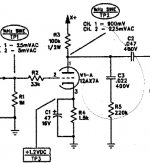I have this pre-amp stage on a fender amp and i get all the voltages right except on the cathode where i get 0 voltage!
I checked all connections and i saw that everything works well, the RC is not bad or open and they are connected to the gnd one side and to pin3 on the other side!
I still can't get the 1.2 dc voltage!
As the tube is a 12AX7 I get the voltages right on the other half of the tube and the filaments are heated correctly!
Any ideas on what else to check?
Any ideas on how to proceed?
Is it by any chance caused by a bad valve? I already tried 3 different ones...
Plate voltage supply: 250V
I checked all connections and i saw that everything works well, the RC is not bad or open and they are connected to the gnd one side and to pin3 on the other side!
I still can't get the 1.2 dc voltage!
As the tube is a 12AX7 I get the voltages right on the other half of the tube and the filaments are heated correctly!
Any ideas on what else to check?
Any ideas on how to proceed?
Is it by any chance caused by a bad valve? I already tried 3 different ones...
Plate voltage supply: 250V
Attachments
Make sure that the cathode capacitor is not leaky/shorted and the tube makes good contact in the socket. Otherwise, you could have an open cathode resistor, or open plate resistor.
Or it's just oxidation on the tube pins or the socket.
Or it's just oxidation on the tube pins or the socket.
0 volts at the cathode suggests a short circuit between cathode and ground, not an open circuit. Check that your cathode bypass cap is connected the right way round and is not faulty.
ray_moth said:0 volts at the cathode suggests a short circuit between cathode and ground, not an open circuit.
Yes sorry I confused

A couple of additional thoughts.
Check the cathode bypass capacitor, it could be shorted. Obviously check the resistor as well.
Are you sure that your meter works properly on the lowest dc range/ranges - quick check with any fresh 1.5V battery.
You did have the meter set for DC volts.. (It should read 0 if set to AC)
Finally open grid leak resistor usually results in tube saturating as it is essentially a diode connection. You would have several volts across the cathode resistor if that were the case.
Good luck
Check the cathode bypass capacitor, it could be shorted. Obviously check the resistor as well.
Are you sure that your meter works properly on the lowest dc range/ranges - quick check with any fresh 1.5V battery.
You did have the meter set for DC volts.. (It should read 0 if set to AC)
Finally open grid leak resistor usually results in tube saturating as it is essentially a diode connection. You would have several volts across the cathode resistor if that were the case.
Good luck
Zero volts is caused by either a short from the cathode to ground (unlikely) or the tube is not conducting any current. To find out which, measure the plate voltage. If is is near 250 the tube is not conducting any current. If it is low, below 100 volts then the tube is conducting heavily and I would suspect a cathode short.
If the tube is not conducting, it could be casued by an open circuit at the grid of the tube. Many small signal tubes will go into cutoff if the grid circuit is open. This is caused by electrons collecting on the grid and building up a negative voltage. This is what a "grid leak" resistor was for to allow these electrons to leak off. Were talking the 1920's here. It could also be a bad tube socket.
There is another possibility, no plate voltage. Again measure it. No(or very low) plate voltage will cause no tube current. The plate load resistor could be open, ot the coupling capacitor to the next stage could be shorted.
If the tube is not conducting, it could be casued by an open circuit at the grid of the tube. Many small signal tubes will go into cutoff if the grid circuit is open. This is caused by electrons collecting on the grid and building up a negative voltage. This is what a "grid leak" resistor was for to allow these electrons to leak off. Were talking the 1920's here. It could also be a bad tube socket.
There is another possibility, no plate voltage. Again measure it. No(or very low) plate voltage will cause no tube current. The plate load resistor could be open, ot the coupling capacitor to the next stage could be shorted.
I get this feeling that your heater is not lighting up on the tube..
Check that the tube is lighting up ......
Chris
Check that the tube is lighting up ......
Chris
- Status
- Not open for further replies.
- Home
- Amplifiers
- Tubes / Valves
- Any help on sth probably simple?
